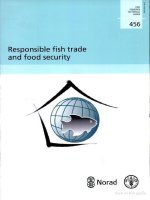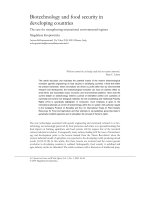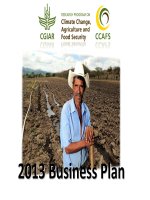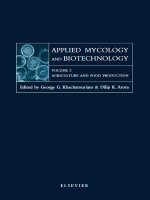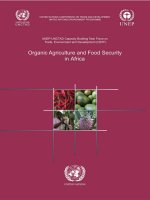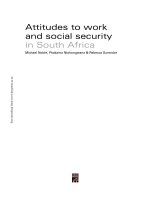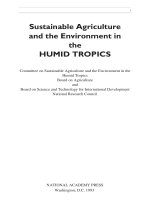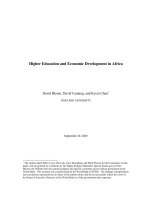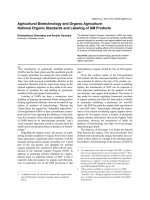Organic Agriculture and Food Security in Africa pot
Bạn đang xem bản rút gọn của tài liệu. Xem và tải ngay bản đầy đủ của tài liệu tại đây (463.72 KB, 61 trang )
i
United Nations Conference on Trade and Development
United Nations Environment Programme
Organic Agriculture and
Food Security in
Africa
United Nations
New York and Geneva, 2008
UNEP-UNCTAD Capacity-building Task Force
on Trade, Environment and Development
ii
Note
6\PEROVRI8QLWHG1DWLRQVGRFXPHQWVDUHFRPSRVHGRIFDSLWDOOHWWHUVFRPELQHGZLWK¿JXUHV
0HQWLRQRIVXFKDV\PEROLQGLFDWHVDUHIHUHQFHWRD8QLWHG1DWLRQVGRFXPHQW
The designations employed and the presentation of the material in this publication do not imply
the expression of any opinion whatsoever on the part of the Secretariat of the United Nations
concerning the legal status of any country, territory, city or area, or of its authorities, or concerning
WKHGHOLPLWDWLRQRILWVIURQWLHUVRUERXQGDULHV
7KHYLHZVH[SUHVVHGLQWKLVYROXPHDUHODUJHO\WKRVHRIWKHDXWKRUVDQGGRQRWQHFHVVDULO\UHÀHFW
WKHYLHZVRIWKH81&7$'DQG81(3VHFUHWDULDWV
Material in this publication may be freely quoted or reprinted, but acknowledgement is requested,
WRJHWKHU ZLWK D UHIHUHQFH WR WKH GRFXPHQW QXPEHU$ FRS\ RI WKH SXEOLFDWLRQ FRQWDLQLQJ WKH
quotation or reprint should be sent to the UNCTAD secretariat (c/o Administrative Secretary,
Division on International Trade in Goods and Services, and Commodities, Palais des Nations,
*HQHYD6ZLW]HUODQG
,QIRUPDWLRQRQ&%7)DFWLYLWLHVLVDYDLODEOHRQWKH&%7)ZHEVLWHKWSZZZXQHSXQFWDGRUJ
FEWI
UNCTAD/DITC/TED/2007/15
UNITED NATIONS PUBLICATION
Copyright © United Nations, 2008
All rights reserved
iii
Foreword
)RRGVHFXULW\LVDQLVVXHRIJUHDWDQGJURZLQJFRQFHUQLQPDQ\FRXQWULHVSDUWLFXODUO\LQ$IULFD
Despite global pledges, the recent report of the United Nations Special Rapporteur on the Right
to Food highlighted that the number of people suffering from hunger has increased every year
VLQFH
Feeding over 6 billion people – and over 9 billion by 2050 – will require a wide range of creative,
sustainable agricultural systems which not only provide food, but also factor in the economic value
RIQDWXUHEDVHGVHUYLFHVVXFKDVIRUHVWVZHWODQGVDQGVRLORUJDQLVPVWKDWXQGHUSLQDJULFXOWXUH
6LPSO\DSSO\LQJWKH³LQGXVWULDO´DJULFXOWXUDOPRGHOVRIWKHWZHQWLHWKFHQWXU\LQWRWKHWZHQW\¿UVW
DVDVLQJOHJOREDOVROXWLRQZLOOQRWVHUYHXVZHOO
The United Nations Conference on Trade and Development (UNCTAD) and the United Nations
(QYLURQPHQW3URJUDPPH81(3WKURXJKWKHLUMRLQW&DSDFLW\%XLOGLQJ7DVN)RUFHRQ7UDGH
Environment and Development (CBTF), take food security very seriously and have joined forces
WRFRQWULEXWHWRWKHVHDUFKIRUVXVWDLQDEOHVROXWLRQV
This study examines the relationship between organic agriculture and food security in Africa,
particularly East Africa, which is where the CBTF has been implementing a project on organic
DJULFXOWXUHVLQFH2UJDQLFDJULFXOWXUHLVDKROLVWLFSURGXFWLRQV\VWHPEDVHGRQDFWLYHDJUR
HFRV\VWHPPDQDJHPHQWUDWKHUWKDQRQH[WHUQDOLQSXWVDQGLWXWLOL]HVERWKWUDGLWLRQDODQGVFLHQWL¿F
NQRZOHGJH
The evidence presented in this study supports the argument that organic agriculture can be more
conducive to food security in Africa than most conventional production systems, and that it is
PRUHOLNHO\WREHVXVWDLQDEOHLQWKHORQJWHUP
7KLVLVLQOLQHZLWKWKH¿QGLQJVRIWKH)RRGDQG$JULFXOWXUDO2UJDQL]DWLRQRIWKH8QLWHG1DWLRQV
)$2,QWHUQDWLRQDO&RQIHUHQFHRQ2UJDQLF$JULFXOWXUHDQG)RRG6HFXULW\KHOGLQ0D\
Therefore, we encourage policymakers and development cooperation partners in Africa and
DURXQGWKHZRUOGWRWDNHDQHZORRNDWWKLVSURPLVLQJSURGXFWLRQV\VWHPZLWKIUHVKH\HV,WRIIHUV
not only improved food security, but also an array of other economic, environmental, health and
VRFLDOEHQH¿WV
Supachai Panitchpakdi Achim Steiner
6HFUHWDU\*HQHUDORI81&7$' ([HFXWLYH'LUHFWRURI81(3
iv
Acknowledgements
This study was prepared by Rachel Hine and Jules Pretty, University of Essex and Sophia Twarog
81&7$'7KHDXWKRUVFDQEHFRQWDFWHGDWWKH&HQWUHIRU(QYLURQPHQWDQG6RFLHW\8QLYHUVLW\
RI(VVH[&ROFKHVWHU(VVH[&2648QLWHG .LQJGRPHPDLOUHKLQH#HVVH[DFXNRUDWWKH
Trade and Sustainable Development Section, Division on International Trade, UNCTAD, Palais
GHV1DWLRQV*HQHYD6ZLW]HUODQGHPDLOVRSKLDWZDURJ#XQFWDGRUJ
Sophia Twarog (UNCTAD) and Asad Naqvi (UNEP/CBTF) oversaw the publication process under
WKHRYHUDOOVXSHUYLVLRQRI8OULFK+RIIPDQQ81&7$'DQG+XVVHLQ$ED]D81(33UDYHHQ
Bhalla (consultant to UNCTAD), Paul Stephenson (UNCTAD), Michael Gibson (UNCTAD) and
$QQD*ULJJVIRUPHUO\ZLWK81&7$'SURYLGHGDVVLVWDQFHRQODQJXDJHHGLWLQJLVVXHV.DULP
Ouahidi (UNEP), Desirée Leon (UNEP) and Rahila Mughal (UNEP) provided administrative
VXSSRUW6RSKLD&RPEHWWH81&7$'GHVLJQHGWKHFRYHU5DIH'HQW81&7$'IRUPDWWHGWKH
PDQXVFULSW
The authors are grateful to the following for contributing valuable information and insights to
the study:
Peter Murage, Mount Kenya Organic Farm (MOOF), Kenya;
J Ngugi Mutura, Sustainable Agriculture Community Development Programme
(SACDEP), Kenya;
Charles Wasonga, Environmental Action Team (EAT), Kenya;
Donati Alex Senzia, Participatory Ecological Land Use Management (PELUM),
United Republic of Tanzania;
-RKQ:1MRURJH.HQ\D,QVWLWXWHRI2UJDQLF)DUPLQJ.,2).HQ\D
Zia R Khan, International Centre of Insect Physiology and Ecology (ICIPE), Kenya;
Moses Muwanga, National Organic Agricultural Movement of Uganda (NOGAMU),
Uganda;
Jordan Gama, Tanzania Organic Agriculture Movement (TOAM), United Republic
of Tanzania;
Eustace Kiarii, Kenya Organic Agriculture Network (KOAN), Kenya;
3HWUD%DNHZHOO6WRQH1RUZHJLDQ8QLYHUVLW\RI/LIH6FLHQFH1RUZD\
Ulrich Hoffmann, UNCTAD;
Fulai Sheng, UNEP;
Benjamin Simmons, UNEP;
Gunnar Rundgren, Grolink, Sweden;
Hervé Bouagnimbeck, International Federation of Organic Agriculture Movements
(IFOAM); and
Participants in the CBTF East African Organic Agriculture Initiative who provided
feedback on the terms of reference and drafts of this paper when they were presented
DW &%7) PHHWLQJV 3DUWLFXODU WKDQNV JR WR PHPEHUV RI WKH &%7) SURMHFW¶V 5HJLRQDO
Steering Committee: From Kenya: Naftali Ndugire, National Environment Management
$XWKRULW\(XVWDFH.LDULL.2$1DQG&HFLOLD.LPHPLD%ULGJH$IULFD)URPWKH8QLWHG
Republic of Tanzania: Geoffrey Kirenga and Adah Mwasha, Ministry of Agriculture, Food
6HFXULW\ DQG &RRSHUDWLYHV-RUGDQ *DPD 72$0 DQG/R\FH/HPD (QYLURFDUH )URP
Uganda: Florence Kata, Ben Naturinda and Bosco Okello, Ugandan Export Promotion
Board; Moses Muwanga, NOGAMU; and Godber Tumushabe, Advocates Coalition on
'HYHORSPHQWDQGWKH(QYLURQPHQW$&2'(
The CBTF East African Organic Agriculture Initiative activities were made possible through
WKHJHQHURXV¿QDQFLDOVXSSRUWRIWKH(XURSHDQ8QLRQWKH6ZHGLVK,QWHUQDWLRQDO'HYHORSPHQW
&RRSHUDWLRQ$JHQF\6LGDDQGWKH*RYHUQPHQWRI1RUZD\
•
•
•
•
•
•
•
•
•
•
•
•
•
•
•
•
v
Contents
Acknowledgements iv
Acronyms vi
Executive summary vi
i
Section 1. Overview 1
,QWURGXFWLRQ 1
$JULFXOWXUDOSURGXFWLRQDQGIRRGVHFXULW\LQ$IULFD 1
7KHIRRGVHFXULW\FKDOOHQJH 2
&DXVHVRIIRRGLQVHFXULW\ 3
)RRGVHFXULW\FKDOOHQJHVIRUDJULFXOWXUHLQ$IULFD 5
6XVWDLQDELOLW\LQDJULFXOWXUH 6
2UJDQLFDJULFXOWXUH 6
7KHH[WHQWRIRUJDQLFDJULFXOWXUHLQ$IULFDSDUWLFXODUO\(DVW$IULFD 8
Section 2. Evidence from Africa 11
,QFUHDVLQJIRRGVHFXULW\ZLWKRUJDQLFDJULFXOWXUH 11
2.1.1 Improvements in availability of food 11
2.1.2 Improvements to natural capital 12
2.1.3 Improvements to social capital 13
2.1.4 Improvements to human capital 13
2.1.5 Improvements to physical capital 14
,PSURYHPHQWVWR¿QDQFLDOFDSLWDO 14
2.1.7 Improvements to external factors 15
2.1.8 Summary 15
(YLGHQFHRQRUJDQLFDJULFXOWXUHDQGIRRGDYDLODELOLW\LQ$IULFD 16
7\SRORJ\RIPHFKDQLVPVE\ZKLFKRUJDQLFDJULFXOWXUHLPSURYHVQDWXUDO
VRFLDOKXPDQSK\VLFDODQG¿QDQFLDOFDSLWDO 16
1DUUDWLYHFDVHVWXGLHVIURP(DVW$IULFD 19
2.4.1 The Manor House Agricultural Centre, Kitale, Kenya 19
2.4.2 Organic cotton, GTZ, United Republic of Tanzania 19
2.4.3 SACDEP, Thika, Kenya 20
&HUWL¿HGRUJDQLFFRWWRQLQ8JDQGD 21
2.4.5 C-MAD programme, Kenya 22
2.4.6 Small-scale aquaculture in Malawi 22
2.4.7 ICIPE YXWXVXNXPX (push-pull) pest management, Kenya 23
2.4.8 Ethiopia: Cheha integrated rural development project 24
2.4.9 MEFE project, Kakamega, Kenya 25
2.4.10 LOMADEF, Lipangwe, Malawi 25
2.4.11 Organic cashews and vegetables in Mkuranga district,
United Republic of Tanzania 26
2.4.12 Soil and crop productivity improvements, EAT, Kenya 27
2.4.13 PEEST project, Iganga district, Uganda 29
2.4.14 MOOF, Kenya 30
2.4.15 PELUM, United Republic of Tanzania 31
2.4.16 Discussion of evidence 32
/LPLWDWLRQVDQGFKDOOHQJHVWRWKHVSUHDGRIRUJDQLFDJULFXOWXUHLQ$IULFD34
2.5.1 Knowledge 34
2.5.2 Support and infrastructure 35
2.5.3 Winners and losers 36
2.5.4 Gender, employment, health and land tenure issues 36
2.5.5 External factors 36
2.5.6 Participatory development policies for organic agriculture 37
Section 3. Conclusions 39
References 41
Annex: Main stakeholders in the organic sector in Kenya, United Republic
of Tanzania and Uganda 47
vi
Acronyms
&%7) 81(381&7$' &DSDFLW\ %XLOGLQJ 7DVN )RUFH RQ 7UDGH (QYLURQPHQW DQG
Development
&0$' &RPPXQLW\0RELOL]DWLRQ$JDLQVW'HVHUWL¿FDWLRQ
CSO civil society organization
EAOPS East African Organic Products Standard
EAT Environmental Action Team
EPOPA Export Promotion of Organic Products from Africa
FAO Food and Agriculture Organization of the United Nations
+,9$,'6 KXPDQLPPXQRGH¿FLHQF\YLUXVDFTXLUHGLPPXQRGH¿FLHQF\V\QGURPH
IAASTD International Assessment of Agricultural Knowledge, Science and Technology for
Development
ICIPE International Centre for Insect Physiology and Ecology
ICLARM International Center for Living Aquatic Resources Management (WorldFish
Center)
ICS internal control system
IPM Integrated Pest Management
IFOAM International Federation of Organic Agriculture Movements
GEF Global Environment Facility
*02 JHQHWLFDOO\PRGL¿HGRUJDQLVP
GTZ Deutsche Gesellschaft für Technische Zusammenarbeit
KD KHFWDUHVTXDUHPHWHUVRUDFUHV
KIOF Kenya Institute of Organic Farming
KOAN Kenya Organic Agriculture Network
LOMADEF Lipangwe Organic Manure Demonstration Farm
MEFE Mumias Education for Empowerment
MOOF Mount Kenya Organic Farm
NA not applicable
1*2 QRQJRYHUQPHQWDORUJDQL]DWLRQ
NOGAMU National Organic Agricultural Movement of Uganda
PEEST Poverty Eradication through Environmentally Sustainable Technologies
PELUM Participatory Ecological Land Use Management
SACDEP Sustainable Agriculture Community Development Programme
SFO smallholder farmer organization
Sida Swedish International Development Cooperation Agency
7DQ&HUW 7DQ]DQLD2UJDQLF&HUWL¿FDWLRQ$VVRFLDWLRQ
TOAM Tanzania Organic Agriculture Movement
UNCTAD United Nations Conference on Trade and Development
81(6&2 8QLWHG1DWLRQV(GXFDWLRQDO6FLHQWL¿FDQG&XOWXUDO2UJDQL]DWLRQ
UNEP United Nations Environment Programme
UNDP United Nations Development Programme
WHO World Health Organization
vii
Executive summary
Introduction
Organic agriculture is a sustainable and environmentally friendly production system that offers
African and other developing countries a wide range of economic, environmental, social and
FXOWXUDOEHQH¿WV:KHQWKH81(381&7$'&DSDFLW\%XLOGLQJ7DVN)RUFHRQ7UDGH(QYLURQPHQW
and Development (CBTF) started its work on organic agriculture in East Africa in 2004, a key
question repeatedly raised by public and private sector stakeholders in the region was to what
H[WHQW RUJDQLF DJULFXOWXUH FDQ HQKDQFH IRRG VHFXULW\ LQ WKH $IULFDQ FRQWH[W 7KLV SDSHU ZDV
GHYHORSHGLQUHVSRQVHWRWKDWTXHVWLRQ,WH[DPLQHVWKHUHODWLRQVKLSEHWZHHQRUJDQLFDJULFXOWXUH
DQGIRRGVHFXULW\LQ$IULFDDQDO\VLQJRUJDQLFDJULFXOWXUH¶VLPSDFWRQIRRGDYDLODELOLW\DVZHOO
DVQDWXUDOVRFLDOKXPDQSK\VLFDODQG¿QDQFLDOFDSLWDOLQWKHUHJLRQ*LYHQWKHSDSHU¶VRULJLQV
special attention has been given to East Africa throughout the paper, including analysis of 15 case
VWXGLHV7KHFRQFOXVLRQVDQG¿QGLQJVDUHKRZHYHUUHOHYDQWIRUDOO$IULFDQFRXQWULHVDVZHOODV
PDQ\RWKHUGHYHORSLQJFRXQWULHVDURXQGWKHZRUOG
Food security and agricultural production
Modern agricultural methods have resulted in spectacular increases in productivity: more cereals and
DQLPDOVSHUKHFWDUHPRUHPHDWDQGPLONSHUDQLPDOPRUHIRRGRXWSXWSHUSHUVRQHPSOR\HG+RZHYHU
the majority of the chronically hungry are small farmers in developing countries who produce much
RIZKDWWKH\HDWDUHRIWHQWRRSRRUWRSXUFKDVHLQSXWVDQGDUHPDUJLQDOL]HGIURPSURGXFWPDUNHWV
In the last 10 years, progress in the drive to reduce hunger has been slow and has varied around
WKHZRUOGLQVXE6DKDUDQ$IULFDWKHQXPEHURIKXQJU\SHRSOHKDVLQIDFWLQFUHDVHGE\SHU
FHQWVLQFH In the period 2000–2002, the proportion of undernourished people in the total
population of Kenya was 33 per cent, in Uganda 19 per cent and in the United Republic of
7DQ]DQLDSHUFHQW7KHQXPEHURIXQGHUZHLJKWFKLOGUHQKDVDOVRLQFUHDVHGLQ&HQWUDO:HVWHUQ
and Eastern Africa compared to an overall decline in other developing regions such as Asia, South
$PHULFDDQG1RUWK$IULFD
1
7KHZRUOGWKHUHIRUH VWLOO IDFHV DIXQGDPHQWDO IRRG VHFXULW\FKDOOHQJH 'HVSLWHVWHDGLO\ IDOOLQJ
fertility rates and family sizes, the world population continues to increase, and so, in parallel, will
WKHDEVROXWHGHPDQGIRUIRRG)RRGGHPDQGZLOODOVRVKLIWLQWKHFRPLQJGHFDGHVDVLHFRQRPLF
JURZWK LQFUHDVHV SHRSOH¶V SXUFKDVLQJ SRZHU LL JURZLQJ XUEDQL]DWLRQ HQFRXUDJHV SHRSOH WR
DGRSWQHZGLHWVDQGLLLFOLPDWHFKDQJHWKUHDWHQVERWKODQGDQGZDWHUUHVRXUFHV
The conventional wisdom is that, in order to double food supply, efforts need to be redoubled to
PRGHUQL]HDJULFXOWXUH6XFKDVWUDWHJ\KDVEHHQVXFFHVVIXOLQWKHSDVW%XWWKHUHDUHGRXEWVDERXW
WKHFDSDFLW\RIVXFKV\VWHPVWRUHGXFHIRRGSRYHUW\7KHJUHDWWHFKQRORJLFDOSURJUHVVLQWKHSDVW
KDOIFHQWXU\KDVQRWOHGWRPDMRUUHGXFWLRQVLQKXQJHUDQGSRYHUW\LQGHYHORSLQJFRXQWULHV
2
Arguably, the most sustainable choice for agricultural development and food security is therefore
to increase total farm productivity in situ, in the developing countries that are the most in need of
JUHDWHUIRRGVXSSOLHV Attention must focus on the following:
L 7KHH[WHQWWRZKLFKIDUPHUVFDQLPSURYHIRRGSURGXFWLRQDQGUDLVHLQFRPHVZLWKORZ
FRVWORFDOO\DYDLODEOHWHFKQRORJLHVDQGLQSXWVWKLVLVSDUWLFXODUO\LPSRUWDQWDWWLPHVRI
YHU\KLJKIXHODQGDJURFKHPLFDOSULFHV
(ii) Whether they can do this without causing further environmental damage; and
LLL7KHH[WHQWRIIDUPHUV¶DELOLW\WRWUDGH
1
)$2YRQ%UDXQ816&1
2
7UHZH\DV6PLO7LOPDQHWDO0F1HHO\DQG6FKHUU
viii
The food security of any region is not simply a question of producing enough food to meet demand;
LWLVDOVRLQÀXHQFHGE\DPXOWLWXGHRIIDFWRUVERWKQDWXUDODQGFDXVHGE\KXPDQV,QFUHDVHGIRRG
VXSSO\GRHVQRWDXWRPDWLFDOO\PHDQLQFUHDVHGIRRG VHFXULW\ IRU DOO:KDWLVLPSRUWDQWLVZKR
produces the food, who has access to the technology and knowledge to produce it, and who has
WKHSXUFKDVLQJSRZHUWRDFTXLUHLW)XUWKHUPRUHPDQ\RIWKHFDXVHVRIIRRGLQVHFXULW\DUHDOVR
V\PSWRPVWKXVFUHDWLQJDF\FOLFDOHIIHFWWKDWFDQUHVXOWLQIXUWKHUIRRGLQVHFXULW\
Organic agriculture and food security
$JULFXOWXUH E\ LWVLQKHUHQW PXOWLIXQFWLRQDOLW\ KDVWKHSRWHQWLDO WR ERWKLQÀXHQFH DQG DGGUHVV
WKHIDFWRUVWKDWFRQWULEXWHWRIRRGLQVHFXULW\2UJDQLFDJULFXOWXUHUHOLHVRQ¿YHFDSLWDODVVHWVIRU
VXFFHVVQDWXUDOVRFLDOKXPDQSK\VLFDODQG¿QDQFLDODQGVRFRQWULEXWHVWRDQGEXLOGVXSVWRFNV
of these natural, social and economic resources over time
3
thus often reducing many of the factors
WKDWOHDGWRIRRGLQVHFXULW\
Increase in food availability
In developing countries, evidence from research and from this study shows that agricultural yields
in organic systems do not fall, and at least remain stable when converting from systems that
XVH UHODWLYHO\ ORZDPRXQWV RI V\QWKHWLFLQSXWV PDQ\RIZKLFK ZHUHE\SDVVHG E\ WKHHDUOLHU
³JUHHQUHYROXWLRQ´VXFKDVWKRVHIUHTXHQWO\IRXQGLQ$IULFD2YHUWLPH\LHOGVLQFUHDVHDVFDSLWDO
assets in systems improve, thus outperforming those in traditional systems and matching those in
PRUHFRQYHQWLRQDOLQSXWLQWHQVLYHV\VWHPV)RRGDYDLODELOLW\LQFUHDVHGLQDOOFDVHVFHQWUHGRQ
IRRGSURGXFWLRQZKHUHGDWDZHUHUHSRUWHGH[DPLQHGLQWKLVVWXG\2WKHUVVXFKDV*LEERQDQG
Bolwig (2007), have also found that organic conversion in tropical Africa is associated with yield
LQFUHDVHVUDWKHUWKDQZLWK\LHOGUHGXFWLRQV
2UJDQLF IDUPLQJ LQFUHDVHV DFFHVV WR IRRG RQ VHYHUDO OHYHOV )LUVW LQFUHDVHG TXDQWLW\ RI IRRG
produced per farm leads to household food security which results in all members of the household
KDYLQJ DFFHVV WR HQRXJK IRRG 6HFRQG WKH SURGXFWLRQ DQG VHOOLQJ RI IRRG VXUSOXVHV DW ORFDO
PDUNHWVPHDQVWKDWIDUPHUVEHQH¿WIURPKLJKHULQFRPHVZKLFKLQFUHDVHVWKHLUSXUFKDVLQJSRZHU
7KLUGIUHVKRUJDQLFSURGXFHEHFRPHVDYDLODEOHWRPRUHSHRSOHLQWKHZLGHUFRPPXQLW\)LQDOO\
organic farming enables new and different groups in a community to get involved in agricultural
SURGXFWLRQDQGWUDGHZKHUHSUHYLRXVO\WKH\ZHUHH[FOXGHGIRU¿QDQFLDORUFXOWXUDOUHDVRQV
%HQH¿WVWRWKHQDWXUDOHQYLURQPHQW
The vast majority of the case studies in this research showed improvements to the natural capital
EDVH±WKHLUORFDOQDWXUDOHQYLURQPHQW±ZLWKSHUFHQWRIWKHFDVHVWXGLHVUHSRUWLQJEHQH¿WVWRVRLO
IHUWLOLW\ZDWHUVXSSO\ÀRRGFRQWURODQGELRGLYHUVLW\2UJDQLFIDUPLQJOHDGVWRPDQ\LPSURYHPHQWV
to the natural environment, including increased water retention in soils, improvements in the water
table (with more drinking water in the dry season), reduced soil erosion combined with improved
RUJDQLFPDWWHULQVRLOVOHDGLQJWREHWWHUFDUERQVHTXHVWUDWLRQDQGLQFUHDVHGDJURELRGLYHUVLW\
As a result soils are healthier, are better able to hold water and are more stable, can sustain plant
JURZWKEHWWHUDQGKDYHDKLJKHUQXWULHQWFRQWHQW$OOWKLVHQDEOHVIDUPHUVWRJURZFURSVIRUORQJHU
SHULRGVZLWKKLJKHU\LHOGVDQGLQPDUJLQDOFRQGLWLRQV7KLVRIFRXUVHFDQPDNHDPDMRULPSDFW
RQUHGXFLQJWKHIRRGLQVHFXULW\RIDUHJLRQ
%HQH¿WVWRFRPPXQLW\FRRSHUDWLRQDQGSDUWQHUVKLSV
Organic agriculture leads to improvements in social capital, including more and stronger social
organizations at local level, new rules and norms for managing collective natural resources and
EHWWHUFRQQHFWHGQHVVWRH[WHUQDOSROLF\LQVWLWXWLRQV5HVXOWVIURPWKHFDVHVLQWKLVVWXG\UHYHDOHG
WKDWSHUFHQWRIWKRVHLQYROYHGFLWHGLPSURYHPHQWVWRVRFLDOFDSLWDODVLQWHJUDOWRWKHLUVXFFHVV
3
2VWURP3UHWW\
ix
7KHIRUPDWLRQRIIDUPHUV¶JURXSVDQGFRRSHUDWLYHVDQGOHVVIRUPDOFRPPXQLW\FROODERUDWLRQKDV
lowered the costs of working, led to increased knowledge transfer amongst farmers, reduced the
FRVWVRIRUJDQLFFHUWL¿FDWLRQDQGFRQWULEXWHGWRJUHDWHUIRRGVHFXULW\
6WURQJ QHWZRUNV DQG OLQNV ZLWK SDUWQHUV IURP JRYHUQPHQW QRQJRYHUQPHQWDO RUJDQL]DWLRQV
(NGOs) and organic support organizations such as the Kenya Organic Agriculture Network
(KOAN), the National Organic Agricultural Movement of Uganda (NOGAMU), the Tanzania
Organic Agriculture Movement (TOAM), and the Export Promotion of Organic Products from
$IULFD(323$SURJUDPPHDUHKHOSLQJIDUPHUVWRRUJDQL]HIRURUJDQLFFHUWL¿FDWLRQDFFHVVH[SRUW
and domestic organic markets and gain greater knowledge of sustainable organic techniques,
FURSVDQGPDUNHWV
,QFUHDVHLQHGXFDWLRQVNLOOVDQGKHDOWK
Organic farming leads to an increase in human capital, evident in all of the case studies detailed in
WKLVUHSRUW$OOKDYHVRPHHOHPHQWRIHGXFDWLRQWKDWLQFUHDVHVWKHNQRZOHGJHRIRUJDQLFIDUPLQJ
PHWKRGVDQG WKH VNLOOV RIIDUPHUV,QPDQ\FDVHVWKHUH KDYH EHHQGLUHFW LPSURYHPHQWV LQ WKH
health of individuals and communities as a result of increased knowledge, an increase in food
\LHOGVDQGLPSURYHGDFFHVVWRIRRG7KHDELOLW\RIIDUPHUVWRXVHWKHLUEHWWHUXQGHUVWDQGLQJRIWKH
holistic nature of organic farming to adapt and change their farming systems when faced with new
challenges has resulted in these agricultural systems becoming more resilient to environmental
DQGH[WHUQDOVWUHVVHV
,PSURYHPHQWVWRLQIUDVWUXFWXUHDQGPDUNHWV
Organic farming can also lead to improvements in the infrastructure (communications and
WUDQVSRUWWKURXJKWKHQHHGWRDFFHVVPDUNHWV$FFHVVWRPDUNHWVLVDQHVVHQWLDOSDUWRIRUJDQLF
farming, (particularly crucial for export) and farmers, NGOs and governments can work together
LQRUGHUWRKHOSIDUPHUVWRHDUQSUHPLXPSULFHVIRUWKHLURUJDQLFSURGXFH2IWKHFDVHVWXGLHV
H[DPLQHGSHUFHQWUHSRUWHGLPSURYHPHQWVLQWKHSK\VLFDOLQIUDVWUXFWXUHDQGLQPDUNHWDFFHVV
Access to markets has increased not only for farmers selling their surplus in domestic markets, but
DOVRIRUIDUPHUVVHOOLQJWKHLUFHUWL¿HGRUJDQLFSURGXFHLQLQWHUQDWLRQDOPDUNHWV
,QFUHDVHLQIDUPHUDQGKRXVHKROGLQFRPHV
Poverty is a major contributory factor to food insecurity, and organic farming has a positive
LPSDFWRQSRYHUW\LQDYDULHW\RIZD\V)DUPHUVEHQH¿WIURPLFDVKVDYLQJVDVRUJDQLFIDUPLQJ
precludes the need to purchase synthetic pesticides and fertilizers; (ii) extra incomes gained by
VHOOLQJWKHVXUSOXVSURGXFHUHVXOWLQJIURPWKHFKDQJHWRRUJDQLFLLLSUHPLXPSULFHVIRUFHUWL¿HG
organic produce, obtained primarily in Africa for export but also for domestic markets; and (iv)
DGGHGYDOXHWRRUJDQLFSURGXFWVWKURXJKSURFHVVLQJDFWLYLWLHV7KHVH¿QGLQJVDUHEDFNHGXSE\
studies from Asia and Latin America that concluded that organic farming can reduce poverty in
DQHQYLURQPHQWDOO\IULHQGO\ZD\
4
$ UHFHQWVWXG\ FRQFOXGHGWKDW FHUWL¿HGRUJDQLF IDUPV LQYROYHG LQ SURGXFWLRQIRU H[SRUWZHUH
VLJQL¿FDQWO\PRUHSUR¿WDEOHWKDQWKRVHLQYROYHGLQFRQYHQWLRQDOSURGXFWLRQLQWHUPVRIQHWIDUP
LQFRPHHDUQLQJV
5
The majority of cases examined in this study reported improvements to the
¿QDQFLDOFDSLWDOEDVHDVRQHRIWKHLUVXFFHVVHV2IWKHVHFDVHVSHUFHQWVKRZHGLQFUHDVHVLQ
farmer and household incomes as a result of becoming organic, which contributed to reducing
SRYHUW\OHYHOVDQGWRLQFUHDVLQJUHJLRQDOIRRGVHFXULW\
4
81&7$'*LEERQDQG%ROZLJ7ZDURJ81&7$'
5
*LEERQDQG%ROZLJ81&7$'
x
0DLQ¿QGLQJVDQGFRQFOXVLRQVRIWKHDQDO\VLV
• Organic agriculture can increase agricultural productivity and can raise incomes with
ORZFRVWORFDOO\DYDLODEOHDQGDSSURSULDWHWHFKQRORJLHVZLWKRXWFDXVLQJHQYLURQPHQWDO
GDPDJH )XUWKHUPRUH HYLGHQFH VKRZV WKDW RUJDQLF DJULFXOWXUH FDQ EXLOG XS QDWXUDO
resources, strengthen communities and improve human capacity, thus improving food
VHFXULW\E\DGGUHVVLQJPDQ\GLIIHUHQWFDXVDOIDFWRUVVLPXOWDQHRXVO\
• All case studies which focused on food production in this research where data have been
reported have shown increases in per hectare productivity of food crops, which challenges
WKH SRSXODU P\WK WKDW RUJDQLF DJULFXOWXUH FDQQRW LQFUHDVH DJULFXOWXUDO SURGXFWLYLW\
Organic production allows access to markets and food for farmers, enabling them to
obtain premium prices for their produce (export and domestic) and to use the additional
LQFRPHV HDUQHG WR EX\ H[WUD IRRGVWXIIV HGXFDWLRQ DQGRU KHDOWK FDUH$ WUDQVLWLRQ WR
LQWHJUDWHGRUJDQLFDJULFXOWXUHGHOLYHULQJJUHDWHUEHQH¿WVDWWKHVFDOHRFFXUULQJLQWKHVH
projects, has been shown to increase access to food in a variety of ways: by increasing
\LHOGVLQFUHDVLQJWRWDORQIDUPSURGXFWLYLW\HQDEOLQJIDUPHUVWRXVHWKHLUKLJKHUHDUQLQJV
IURPH[SRUWWREX\IRRGDQGDVDUHVXOWRIKLJKHURQIDUP\LHOGVHQDEOLQJWKHZLGHU
FRPPXQLW\WREX\RUJDQLFIRRGDWORFDOPDUNHWV
2UJDQLF DQG QHDURUJDQLF DJULFXOWXUDO PHWKRGVDQG WHFKQRORJLHV DUH LGHDOO\VXLWHG IRU
many poor, marginalized smallholder farmers in Africa, as they require minimal or no
H[WHUQDO LQSXWV XVH ORFDOO\ DQG QDWXUDOO\ DYDLODEOH PDWHULDOV WR SURGXFH KLJKTXDOLW\
products, and encourage a whole systemic approach to farming that is more diverse and
UHVLVWDQWWRVWUHVV
7KH UHFHQW IRRGSULFH KLNH DQG WKH FRQWULEXWLRQ ULVLQJ IXHO SULFHV KDYH PDGH WR LW
KLJKOLJKWWKHLPSRUWDQFHRIPDNLQJDJULFXOWXUHOHVVHQHUJ\DQGH[WHUQDOLQSXWGHSHQGHQW
Enhanced transition to sustainable forms of agriculture in general, and organic agriculture
LQSDUWLFXODUQHHGVWREHSDUWRIDQHIIHFWLYHUHVSRQVHVWUDWHJ\WRHVFDODWLQJIRRGSULFHV
&HUWL¿HGRUJDQLFSURGXFWLRQIRUWKHH[SRUWPDUNHWZLWKLWVSUHPLXPSULFHVFDQXQGRXEWHGO\
UHGXFHSRYHUW\DPRQJIDUPHUVZKLFKLVDPDMRUFRQWULEXWRUWRIRRGLQVHFXULW\+RZHYHU
monocropping farming systems for the export market, whether conventional or organic,
VWLOOOHDYHIDUPHUVYXOQHUDEOHWRH[SRUWSULFHÀXFWXDWLRQVDQGFURSIDLOXUH:KHUHRUJDQLF
farming principles are adopted as a holistic approach for the whole of an integrated
agricultural system, “organic” can be synonymous with “sustainable”, and increased food
security in a region is more likely to occur, while also building up natural, human and
VRFLDOUHVRXUFHV
2UJDQLF DJULFXOWXUDO V\VWHPVDUHPDNLQJ DVLJQL¿FDQWFRQWULEXWLRQ WR WKHUHGXFWLRQ RI
IRRGLQVHFXULW\DQGSRYHUW\LQDUHDVRI$IULFDDQGWRDQLPSURYHPHQWLQUXUDOOLYHOLKRRGV
There is the potential to do more in this area with enabling policy and institutional
VXSSRUW
2UJDQLFDJULFXOWXUHLVQRWGLUHFWO\DQGVSHFL¿FDOO\VXSSRUWHGE\DJULFXOWXUDOSROLF\LQPRVW
African countries; indeed, it is sometimes actively hindered by policies advocating the
XVHRIKLJKLQSXWIDUPLQJPDQDJHPHQWSUDFWLFHV,IRUJDQLFDJULFXOWXUHDQGLWVDVVRFLDWHG
SRVLWLYHVLGHHIIHFWVDUHWREHVFDOHGXSDQHQDEOLQJSROLF\HQYLURQPHQWLVFULWLFDO
,QWHJUDWHGRUJDQLFDJULFXOWXUHZKHWKHUFHUWL¿HGRUQRQFHUWL¿HGLVPRUHPDQDJHPHQW
DQG NQRZOHGJHLQWHQVLYH DQG VR QHFHVVLWDWHV EXLOGLQJ WKH OHDUQLQJ DQG FRRSHUDWLYH
xi
FDSDFLW\ RILQGLYLGXDOV DQGJURXSV 7KLV UHTXLUHV LQYHVWPHQWLQ GHYHORSLQJWKH VRFLDO
FDSLWDODWWKHORFDOOHYHOLIRUJDQLFDJULFXOWXUHLVWRVSUHDG
0XFKPRUHLVQRZNQRZQDERXWLQWHQVLYHKLJKLQSXWIDUPLQJV\VWHPVWKDQLVNQRZQDERXW
VXVWDLQDEOHRUJDQLFV\VWHPV7KXVPRUHLQIRUPDWLRQRQDJURHFRORJLFDOWHFKQRORJLHVLV
QHHGHG+RZHYHUWKLVFDOOVIRUDVKLIWRIHPSKDVLVLQUHVHDUFKDQGVFLHQFHEXGJHWVDQG
for the creation of better linkages between scientists, agricultural training and extension
SURYLGHUVDQGIDUPHUV
• Partnerships between farmers, farmer groups, NGOs and civil society organizations
(CSOs), organic movement organizations, governments and certifying bodies at all
OHYHOVIRVWHUVXFFHVVIXORUJDQLFDJULFXOWXUH ,Q RUGHU WR IDFLOLWDWH WKHVSUHDGRIRUJDQLF
agriculture there is a need to work at all levels: local, national and international, as well
DVWRHQFRXUDJHPRUHOLQNVEHWZHHQJRYHUQPHQWV1*2VDQGWKHSULYDWHVHFWRU
• Improving agricultural sustainability through adoption of organic agriculture in Africa
may not be a solution to all the food problems, but considerable progress has been made
LQUHFHQW\HDUV:KHWKHURUJDQLFIDUPLQJZLOOUHVXOWLQHQRXJKIRRGWRPHHWFXUUHQWDQG
future needs in response to continued population growth and development in African
FRXQWULHVFDQQHYHUEHWRWDOO\FHUWDLQEXWLVFHUWDLQO\DVWHSLQWKHULJKWGLUHFWLRQ7KH
present situation of widespread food insecurity means that conventional farming systems
DUHFOHDUO\XQDEOHWRIXO¿OWKHFXUUHQWIRRGQHHGVLQ$IULFD7KHUHVXOWVREVHUYHGLQWKH
WUDQVLWLRQWRRUJDQLFDJULFXOWXUHDUHKLJKO\SURPLVLQJIRUIRRGVHFXULW\LQ$IULFD(YLGHQFH
LQGLFDWHVWKDWSURGXFWLYLW\LQRUJDQLFDJULFXOWXUHFDQJURZRYHUWLPH
6
:LWKIXUWKHUVSHFL¿F
VXSSRUW WKHEHQH¿WV WRIRRG VHFXULW\DQG UHODWHGLPSURYHPHQWV WR QDWXUDO VRFLDO DQG
human capital, could spread to much larger numbers of farmers and rural people in the
FRPLQJGHFDGHV
7KHVHFRQFOXVLRQVDUHFRQ¿UPHGE\WKH¿QGLQJVDQGUHFRPPHQGDWLRQVRIWKHUHFHQWO\
released report of the International Assessment of Agricultural Knowledge, Science and
Technology for Development (IAASTD) panel, an intergovernmental process, supported
E\RYHUH[SHUWVXQGHUWKHFRVSRQVRUVKLSRIWKH)$2*()81'381(381(6&2
the World Bank and WHO (issued on 14 April 2008) stated strongly that “the way the
world grows its food will have to change radically to better serve the poor and hungry if
the world is to cope with growing population and climate change while avoiding social
EUHDNGRZQDQGHQYLURQPHQWDOFROODSVH´7KHDXWKRUVIRXQGWKDWLSURJUHVVLQDJULFXOWXUH
KDVUHDSHGYHU\XQHTXDOEHQH¿WVDQGKDVFRPHDWDKLJKVRFLDODQGHQYLURQPHQWDOFRVW
and (ii) food producers should try using “natural processes” like crop rotation and use of
RUJDQLFIHUWLOL]HUV7KHDXWKRUVFDOOIRUPRUHDWWHQWLRQWRVPDOOVFDOHIDUPHUVDQGXWLOL]LQJ
VXVWDLQDEOHDJULFXOWXUDOSUDFWLFHVDQGVSHFL¿FDOO\PHQWLRQRUJDQLFIDUPLQJDVDQRSWLRQ
VHYHUDOWLPHV
7
6
%RUODXJDDQGE$YHU\
7
,$$67'
Overview 1
SECTION 1. OVERVIEW
1.1 Introduction
Organic agriculture is a sustainable and environmentally friendly production system that
offers African and other developing countries a wide range of economic, environmental, social
DQG FXOWXUDO EHQH¿WV
1
:KHQ WKH 81(381&7$' &DSDFLW\ %XLOGLQJ 7DVN )RUFH RQ 7UDGH
Environment and Development (CBTF)
2
started its work on organic agriculture in East Africa
in 2004, a key question repeatedly raised by public and private sector stakeholders in the region
ZDVWRZKDWH[WHQW RUJDQLFDJULFXOWXUHFDQHQKDQFHIRRG VHFXULW\ LQ WKH$IULFDQ FRQWH[W7KLV
SDSHUZDVGHYHORSHGLQUHVSRQVHWRWKDWTXHVWLRQ,WH[DPLQHVWKHUHODWLRQVKLSEHWZHHQRUJDQLF
DJULFXOWXUHDQGIRRGVHFXULW\LQ$IULFDDQDO\VLQJRUJDQLFDJULFXOWXUH¶VLPSDFWRQIRRGDYDLODELOLW\
DVZHOODVQDWXUDOVRFLDOKXPDQSK\VLFDODQG¿QDQFLDOFDSLWDOLQWKHUHJLRQ*LYHQWKHSDSHU¶V
origins, special attention has been given to East Africa throughout the paper, including analysis of
FDVHVWXGLHV7KHFRQFOXVLRQVDQG¿QGLQJVDUHKRZHYHUUHOHYDQWIRUDOO$IULFDQFRXQWULHVDV
ZHOODVPDQ\RWKHUGHYHORSLQJFRXQWULHVDURXQGWKHZRUOG
1.2 Agricultural production and food security in Africa
Over the past 40 years, there has been remarkable growth in agricultural production with per capita
world food production growing by 17 per cent and aggregate world food production growing by
SHUFHQW%HWZHHQWKHHDUO\VDQGPLGVDYHUDJHFHUHDO\LHOGVJUHZIURPWRQV
SHUKHFWDUHWKDWRWKDLQGHYHORSLQJFRXQWULHVZKLOHWRWDOFHUHDOSURGXFWLRQJUHZIURP
WRPLOOLRQWRQQHVSHU\HDU
3
Over the same period, world population grew from three to six billion, but globally per capita
agricultural production overtook population growth, and each person today has 25 per cent more
IRRGFRPSDUHGZLWK+RZHYHUWKLVLVQRWWKHFDVHIRUHYHU\RQH±LWYDULHVUHJLRQDOO\LQ
$IULFDIRUH[DPSOHIRRGSURGXFWLRQSHUSHUVRQLVSHUFHQWORZHUWRGD\WKDQLQ
Modern agricultural methods have brought spectacular increases in productivity: more cereals and
DQLPDOVSHUKHFWDUHPRUHPHDWDQGPLONSHUDQLPDODQGPRUHIRRGRXWSXWSHUSHUVRQHPSOR\HG
$Q\ IDUPHU RU DJULFXOWXUDO V\VWHP ZLWK DFFHVV WR VXI¿FLHQW LQSXWV NQRZOHGJH DQG VNLOOV FDQ
SURGXFHODUJHDPRXQWVRIIRRG+RZHYHUWKHPDMRULW\RIWKHFKURQLFDOO\KXQJU\DUHVPDOOIDUPHUV
in developing countries who produce much of what they eat and are often poor and lack access to
LQSXWVDQGSURGXFWPDUNHWV
The recent advances in aggregate productivity have therefore not brought reductions in the
LQFLGHQFHRIKXQJHUIRUDOO,QWKHHDUO\WZHQW\¿UVWFHQWXU\WKHUHDUHVWLOOPRUHWKDQPLOOLRQ
SHRSOHKXQJU\DQGODFNLQJDGHTXDWHDFFHVVWRIRRG$WKLUGRIWKHVHDUHLQ(DVWDQG6RXWK(DVW
$VLDDQRWKHUWKLUGLQ6RXWK$VLDDTXDUWHUDUHLQVXE6DKDUDQ$IULFDDQGSHUFHQWHDFKDUHLQ
/DWLQ$PHULFDDQGWKH&DULEEHDQDQGLQ1RUWK$IULFDDQG:HVW$VLD
)RRGVHFXULW\FDQEHGH¿QHGDVDFRQGLWLRQZKHUH³DOOSHRSOHDWDOOWLPHVKDYHSK\VLFDODQG
HFRQRPLF DFFHVV WR VXI¿FLHQW VDIH DQG QXWULWLRXV IRRG WR PHHW WKHLU GLHWDU\ QHHGV DQG IRRG
SUHIHUHQFHVIRUDQDFWLYHDQGKHDOWK\OLIH´
4
Indicators of food insecurity in a given region can
include numbers of “hungry” or malnourished people, of underweight children and of people
VXIIHULQJIURPPLFURQXWULHQWGH¿FLHQF\
5
Although average per capita food consumption in 2003 was 2,780 kcal/day, consumption in 33
1
UNCTAD, 2006
2
,QIRUPDWLRQRQ&%7)DFWLYLWLHVLVDYDLODEOHRQWKH&%7)ZHEVLWHKWSZZZXQHSXQFWDGRUJFEWI
3
)$2&RQZD\DQG3UHWW\+HIIHUQDQ6PLO3UHWW\DQG+LQH
4
*LOOHVSLHDQG+DGGDG)$2
5
)$2
2 Organic Agriculture and Food Security in Africa
FRXQWULHVLVVWLOOOHVVWKDQWKHUHFRPPHQGHGNFDOGD\,QDGGLWLRQWRPLOOLRQSHRSOHWKDW
go hungry, globally there are 126 billion underweight children and over 2 billion people suffering
IURP VRPH IRUP RI PLFURQXWULHQW GH¿FLHQF\$OPRVW SHU FHQW RI SUHJQDQW ZRPHQ LQ VXE
6DKDUDQ$IULFDDUHDIIHFWHGE\LURQGH¿FLHQF\DQDHPLD
6
In the last 10 years, progress in the drive to reduce hunger has been slow and has varied around
WKHZRUOGLQVXE6DKDUDQ$IULFDWKHQXPEHURIKXQJU\SHRSOHKDVLQIDFWLQFUHDVHGE\SHU
FHQWVLQFH,QWKHSHULRG±WKHSURSRUWLRQRIXQGHUQRXULVKHGSHRSOHLQWKHWRWDO
population of Kenya was 33 per cent, in Uganda 19 per cent and in the United Republic of
7DQ]DQLDSHUFHQW7KHQXPEHURIXQGHUZHLJKWFKLOGUHQKDVDOVRLQFUHDVHGLQ&HQWUDO:HVW
and East Africa compared to an overall decrease in other developing regions such as Asia, South
$PHULFDDQG1RUWK$IULFD
7
The world therefore still faces a fundamental food security challenge: despite steadily falling
fertility rates and family sizes, the world population continues to increase and so in parallel will
WKHDEVROXWHGHPDQGIRUIRRG)RRGGHPDQGZLOODOVRVKLIWLQWKHFRPLQJGHFDGHVDVHFRQRPLF
JURZWKLQFUHDVHVSHRSOH¶VSXUFKDVLQJSRZHUJURZLQJXUEDQL]DWLRQHQFRXUDJHVSHRSOHWRDGRSW
QHZGLHWVDQGFOLPDWHFKDQJHWKUHDWHQVERWKODQGDQGZDWHUUHVRXUFHV
World population is widely expected to reach 9 billion by the next generation, by when 84 per cent
RIWKHWRWDOSRSXODWLRQZLOOOLYHLQWKRVHFRXQWULHVFXUUHQWO\FRPSULVLQJWKH³GHYHORSLQJ´ZRUOG$W
the same time, land and water degradation is increasingly posing a threat to food security and the
OLYHOLKRRGVRIUXUDOSHRSOHZKRRIWHQOLYHRQGHJUDGDWLRQSURQHODQGV$OWKRXJKDFRPELQDWLRQRI
increased production and more imports will mean per capita consumption will increase by 2015,
a person living in a developing country will still only consume half of the cereals and a third of
the meat consumed by a person in an industrialized country, which implies that food insecurity
DQGPDOQXWULWLRQZLOOSHUVLVW
8
7KHIRRGVHFXULW\FKDOOHQJH
What makes agriculture unique as an economic sector is that it directly affects many of the natural,
VRFLDODQGHFRQRPLFUHVRXUFHVRQZKLFKLWUHOLHVIRUVXFFHVV$JULFXOWXUDOV\VWHPVDWDOOOHYHOVUHO\
RQWKHYDOXHRIVHUYLFHVÀRZLQJIURPWKHWRWDOVWRFNRIDVVHWVWKDWWKH\LQÀXHQFHDQGFRQWURO)LYH
W\SHVRI³FDSLWDO´DVVHWVQDWXUDOVRFLDOKXPDQSK\VLFDODQG¿QDQFLDOFDSLWDOZKLFKDUHQRZ
recognized as being important,
9
are described below:
1. Natural capital SURGXFHV HQYLURQPHQWDO JRRGV DQG VHUYLFHV ,W LV WKH VRXUFH RI IRRG
IDUPHG DQG KDUYHVWHG RU FDXJKW IURP WKH ZLOG ZRRG DQG ¿EUH ZDWHU VXSSO\ DQG
regulation; treatment, assimilation and decomposition of wastes; nutrient cycling and
¿[DWLRQVRLOIRUPDWLRQELRORJLFDOFRQWURORISHVWVFOLPDWHUHJXODWLRQZLOGOLIHKDELWDWV
VWRUPSURWHFWLRQDQGÀRRGFRQWUROFDUERQVHTXHVWUDWLRQSROOLQDWLRQDQGODQGVFDSH
10
2. Social capital SURGXFHV D PXWXDOO\ EHQH¿FLDO FROOHFWLYH DFWLRQ FRQWULEXWLQJ WR WKH
FRKHVLYHQHVV RI SHRSOHLQWKHLU VRFLHWLHV7KH DVVHWVFRPSULVLQJVRFLDO FDSLWDO LQFOXGH
norms, values and attitudes that prompt people to cooperate; relations of trust, reciprocity
and obligations; and common rules and sanctions that are mutually agreed or handed
GRZQ7KHVHDUHFRQQHFWHGDQGVWUXFWXUHGLQQHWZRUNVDQGJURXSV
11
6
FAO, 2005; von Braun, 2005; FAO, 2005; UN/SCN, 2004; Micronutrient Initiative and UNICEF, 2005; IFPRI,
7
)$2YRQ%UDXQ816&1
8
YRQ%UDXQ8SKRII3LQVWUXS$QGHUVHQHWDO3UHWW\DQG+LQH
9
&ROHPDQDQG3XWQDPDQG&RVWDQ]DHWDODQG&DUQH\)ORUD
Ostrom, 1998; Pretty, 1998; Scoones, 1998; Uphoff, 1998; Pretty and Ward, 2001; Pretty and Hine, 2001; Pretty,
10
&RVWDQ]DHWDO0$
11
)ORUDDQG)ORUD3UHWW\&UDPEDQG&XODVHQR
Overview 3
3. Human capital is the total capability of individuals, based on their stock of knowledge
VNLOOVKHDOWKDQGQXWULWLRQ,WLVHQKDQFHGE\DFFHVVWRVHUYLFHVWKDWSURYLGHWKHVHVXFK
DV VFKRROV PHGLFDO VHUYLFHV DQG DGXOW WUDLQLQJ 3HRSOH¶V SURGXFWLYLW\ LV LQFUHDVHG E\
WKHLUFDSDFLW\WRLQWHUDFWZLWKSURGXFWLYHWHFKQRORJLHVDQGZLWKRWKHUSHRSOH/HDGHUVKLS
and organizational skills are particularly important in making other resources more
YDOXDEOH
12
4. Physical capital is the store of material resources made by humans, and comprises
buildings, such as housing and factories, market infrastructure, irrigation works, roads
and bridges, tools and tractors, communications, and energy and transportation systems,
WKDWPDNHODERXUPRUHSURGXFWLYH
5. Financial capital is more of an accounting concept, as it provides a facilitating role rather
WKDQ EHLQJ D VRXUFH RISURGXFWLYLW\ LQ DQG RI LWVHOI ,W UHSUHVHQWV DFFXPXODWHGFODLPV
RQJRRGVDQGVHUYLFHVEXLOWXSWKURXJK¿QDQFLDOV\VWHPVWKDWJDWKHUVDYLQJVDQGLVVXH
FUHGLWVXFKDVSHQVLRQVUHPLWWDQFHVZHOIDUHSD\PHQWVJUDQWVDQGVXEVLGLHV
As agricultural systems shape these very assets on which they rely for inputs, a vital feedback
ORRSRFFXUVIURPRXWFRPHVWRLQSXWV
13
The basic premise is that more sustainable agricultural
V\VWHPVDFFXPXODWHVWRFNVRIWKHVH¿YHDVVHWVWKHUHE\LQFUHDVLQJDOOWKHIRUPVRIFDSLWDORYHU
WLPH6XVWDLQDEOHDJULFXOWXUDOV\VWHPVWHQGWRKDYHDSDUWLFXODUO\SRVLWLYHHIIHFWRQQDWXUDOVRFLDO
and human capital, while unsustainable systems deplete these assets, leaving less for future
JHQHUDWLRQV
For example: (i) an agricultural system that erodes soil while producing food results in costs
that others must bear;
14
(ii) another system that sequesters carbon in soils through organic matter
accumulation helps to mitigate climate change; (iii) a diverse agricultural system that enhances
RQIDUPZLOGOLIHIRUSHVWFRQWUROFRQWULEXWHVWRJUHDWHUVWRFNVRIELRGLYHUVLW\ZKLOHDVLPSOL¿HG
PRGHUQL]HGV\VWHPWKDWHOLPLQDWHVZLOGOLIHGRHVQRWFRQWULEXWHWRELRGLYHUVLW\DQG¿QDOO\Y
DJULFXOWXUDOV\VWHPVWKDWRIIHUODERXUDEVRUSWLRQRSSRUWXQLWLHV WKURXJK UHVRXUFH LPSURYHPHQWV
RUYDOXHDGGHGDFWLYLWLHVFDQERRVWORFDOHFRQRPLHVDQGKHOSWRUHYHUVHUXUDOWRXUEDQPLJUDWLRQ
SDWWHUQV
15
Agriculture is therefore fundamentally multifunctional, as it involves many unique
IRRGDQGQRQIRRGIXQFWLRQVWKDWFDQQRWEHSURGXFHGE\RWKHUHFRQRPLFVHFWRUVDVHI¿FLHQWO\
7KHUHFHQWIRRGSULFHKLNHDQGWKHFRQWULEXWLRQULVLQJIXHOSULFHVKDYHPDGHWRLWKLJKOLJKWWKH
LPSRUWDQFHRIPDNLQJDJULFXOWXUHOHVVHQHUJ\DQGH[WHUQDOLQSXWGHSHQGHQW(QKDQFHGWUDQVLWLRQ
to sustainable forms of agriculture in general, and organic agriculture in particular, needs to be
SDUWRIDQHIIHFWLYHUHVSRQVHVWUDWHJ\WRHVFDODWLQJIRRGSULFHV
1.4 Causes of food insecurity
,QFUHDVHGIRRGVXSSO\LVDQHFHVVDU\WKRXJKQRWVXI¿FLHQWFRQGLWLRQIRUHOLPLQDWLQJKXQJHUDQG
SRYHUW\7KHIRRGVHFXULW\RIDQ\UHJLRQLVQRWVLPSO\DTXHVWLRQRISURGXFLQJHQRXJKIRRGWR
PHHWGHPDQGLWLVLQÀXHQFHGE\DPXOWLWXGHRIIDFWRUVERWKQDWXUDODQGKXPDQPDGH,QFUHDVHG
IRRGVXSSO\GRHVQRWDXWRPDWLFDOO\PHDQLQFUHDVHGIRRGVHFXULW\IRUDOO:KDWLVLPSRUWDQWLVZKR
produces the food, who has access to the technology and knowledge to produce it, and who has
WKHSXUFKDVLQJSRZHUWRDFTXLUHLW)XUWKHUPRUHPDQ\RIWKHFDXVHVRIIRRGLQVHFXULW\DUHDOVR
V\PSWRPVWKXVFUHDWLQJDF\FOLFDOHIIHFWWKDWFDQUHVXOWLQIXUWKHUIRRGLQVHFXULW\
Box 1 shows the factors contributing to food insecurity in Africa, both natural and those caused
E\KXPDQV
12
2UU%\HUOHH/LHEOLQHWDO/HHXZLV
13
:RUVWHU3UHWW\DQG+LQH
14
2IWHQUHIHUUHGWRDVH[WHUQDOLWLHV
15
&DUQH\'DVJXSWD(OOLV3UHWW\HWDO
4 Organic Agriculture and Food Security in Africa
Box 1. Factors contributing to food insecurity in Africa
1. Availability of food
Lack of consistent
access to food
• Enough food may be produced in a region overall, but food insecurity may
persist for those who do not have the resources to buy or produce it.
• Farmers may be able to produce or buy enough food for their families after
harvest but may be food insecure at other times of the year.
a
2. Natural capital
Degraded natural
resources
• A degraded natural environment, such as poor soil quality, eroded landscapes
or inadequate water resources, will compromise food production in an area.
Practice of mono-
cropping
• Monocropped systems are less likely to promote food security than diverse
agricultural systems, which are more resilient to stresses.
3. Social capital
Community and group
issues
• Where there are poor links within and between communities, with limited
networks, partnerships, trust and collective action, credit and responsibility,
communities are less likely to cope with and to be able to help each other in
WLPHVRIKDUGVKLSVXFKDVGURXJKWVIRRGVKRUWDJHVDQGFRQÀLFW)RRGLQVHFXULW\
and ill-health is likely to be greater in areas with lower social capital.
4. Human capital
Lack of education and
knowledge
• Lack of education and agricultural/nutritional knowledge can affect farmers’
capacity to adapt to change or to cope with food production stresses.
Ill-health and diseases • Malnourished people are not able to produce food as effectively as those who
are well fed.
• The prevalence of diseases such as HIV/AIDS has had serious impacts on
food security and nutrition. When family members become ill or die from the
virus, households are less able to produce or buy food.
b
In sub-Saharan Africa,
11 million children are orphaned by HIV/AIDS.
c
Mortality and morbidity in HIV/
AIDS-affected households has led to decreased farm sizes, loss of income
at household level, a higher dependency ratio and a general increase in food
insecurity.
d
Gender issues • In many regions women are the major agricultural labour force. However, as
they are not always recognized for this, they may not control household budgets
and often have poor education.
• In areas where men are in control over the household income, less money
is spent on food when compared to those where women have control over
incomes.
5. Physical capital
Poor infrastructure • Poor infrastructure (roads, communications and markets for example) affects
food security.
Lack of access
to appropriate
technologies
• Lack of appropriate agricultural knowledge, technologies, methods or inputs
can affect food security.
6. Financial capital
Poverty • Poverty remains the root cause of hunger and malnutrition in the world.
e
Lack of access to
markets
• Lack of access to markets means that farmers and communities can neither sell
their surplus nor purchase food in times of shortage. This leads to inconsistent
food availability thus contributing to food insecurity.
7. Other external factors
Land-tenure issues • Land-tenure issues can contribute to food insecurity in a number of ways which
vary depending on the context. For example, in some areas if a husband dies,
the wife cannot continue to farm the land and the land goes to other members
of the family. In East Africa, all of the male children of a man inherit his land
between them on his death, which means that each person owns increasingly
smaller farm plots, making it hard to sustain enough food for the household.
Political issues 3ROLWLFDOSUREOHPVLQFOXGLQJFRUUXSWLRQFROOXVLRQDQGQHSRWLVPFDQVLJQL¿FDQWO\
inhibit attempts to tackle food insecurity.
f
Overview 5
)RRGVHFXULW\FKDOOHQJHVIRUDJULFXOWXUHLQ$IULFD
There are two emerging food security challenges:
+RZWR¿QGZD\VWRPDLQWDLQDQGHQKDQFHIRRGSURGXFWLRQZKLOHVHHNLQJERWKWRLPSURYH
WKHSRVLWLYHVLGHHIIHFWVDQGWRHOLPLQDWHWKHQHJDWLYHRQHV"
This will not be easy, as past agricultural development has tended to ignore both the
PXOWLIXQFWLRQDOLW\RIDJULFXOWXUHDQGWKHFRQVLGHUDEOHH[WHUQDOFRVWV
16
:KDWLVWKHEHVWZD\WRLQFUHDVHDJULFXOWXUDOSURGXFWLYLW\LQ$IULFDDQGRWKHUGHYHORSLQJ
FRXQWULHVZKHUHPLOOLRQVRISHRSOHDUHVWLOOVKRUWRIIRRG"
These questions are controversial, with widely varying positions about strategies which are
likely to be effective, including: (i) expanding the area of agriculture;
17
(ii) increasing per hectare
production in agricultural exporting countries;
18
or (iii) increasing total farm productivity in
GHYHORSLQJFRXQWULHVWKDWDUHWKHPRVWOLNHO\WRQHHGWKHIRRG
The conventional wisdom is that, in order to double food supply, efforts need to be redoubled to
PRGHUQL]HDJULFXOWXUHDVWKLVDSSURDFKKDVEHHQVXFFHVVIXOLQWKHSDVW%XWWKHUHDUHGRXEWVDERXW
WKHFDSDFLW\RIVXFKV\VWHPVWRUHGXFHIRRGSRYHUW\7KHJUHDWWHFKQRORJLFDOSURJUHVVLQWKHSDVW
KDOIFHQWXU\KDVQRWUHVXOWHGLQPDMRUUHGXFWLRQVLQKXQJHUDQGSRYHUW\LQGHYHORSLQJFRXQWULHV
19
Arguably then, the most sustainable choice for agricultural development and food security is to
increase total farm productivity in situ, in the developing countries that are the most likely to need
WKHIRRG7KHFHQWUDOTXHVWLRQVWKHUHIRUHPXVWIRFXVRQWKHIROORZLQJ
L 7KHH[WHQWWRZKLFKIDUPHUVFDQLPSURYHIRRGSURGXFWLRQDQGUDLVHLQFRPHVZLWKORZ
cost, locally available technologies and inputs (this is particularly important at times of
YHU\KLJKIXHODQGDJURFKHPLFDOSULFHV
(ii) Whether they can do this without causing further environmental damage; and
LLL7KHH[WHQWWRZKLFKIDUPHUVKDYHWKHDELOLW\WRWUDGH
16
6HHIRUH[DPSOH3UHWW\HWDODQG
17
By converting new lands to agriculture, but with the result that services from forests, grasslands and other areas of
LPSRUWDQWELRGLYHUVLW\DUHORVW
18
0RVWO\LQLQGXVWULDOL]HGFRXQWULHVVRWKDWIRRGFDQEHWUDQVIHUUHGRUVROGWRWKRVHZKRQHHGLW
19
7UHZH\DV6PLO7LOPDQHWDO0F1HHO\DQG6FKHUU
Climate and natural
disasters
• In areas prone to drought or unreliable rainfall, food security can be particularly
challenging.
• Plagues of natural pests such as locusts can decimate crops.
• Natural disasters may destroy lives, crops, homes and landscapes.
• In the last 20 years, the average number of deaths from natural disasters has
been more than the average for the preceding decade.
g
$UPHGFRQÀLFWVDQG
wars
3ROLWLFDO XQUHVW DUPHG FRQÀLFWV DQG ZDUV FRQWULEXWH WR IRRG LQVHFXULW\ DQG
prevent food from being produced or accessed.
3ROLWLFDOFRQÀLFWVDUHRIWHQDVVRFLDWHGZLWKIRRGLQVHFXULW\DVERWKDFDXVHDQG
an effect.
h
a
Benson, 2004.
b
Rosegrant et al., 2005.
c
FAO, 2002.
d
Rugalema, 1999; Sanchez and Swaminathan, 2005; and Wagah, 2005.
e
IFPRI, 2005.
f Rosegrant et al., 2005.
g
EM-DAT, 2005.
h
Messer and Cohen, 2004
6 Organic Agriculture and Food Security in Africa
1.6 Sustainability in agriculture
Many different expressions have come to be used to imply greater sustainability in some
DJULFXOWXUDOV\VWHPVRYHUSUHYDLOLQJRQHVERWKSUHLQGXVWULDODQGLQGXVWULDOL]HG7KHVHLQFOXGH
ELRG\QDPLFFRPPXQLW\EDVHGHFRDJULFXOWXUHHFRORJLFDOHQYLURQPHQWDOO\VHQVLWLYHH[WHQVLYH
IDUPIUHVK IUHHUDQJHORZLQSXW RUJDQLF SHUPDFXOWXUH VXVWDLQDEOH DQGZLVH XVH7KHUH LV D
continuing and intense debate about whether agricultural systems using some of these practices
FDQTXDOLI\DVVXVWDLQDEOH
20
However highly sustainable agricultural systems can be taken to mean those that aim to make the
EHVWXVHRIHQYLURQPHQWDOJRRGVDQGVHUYLFHVZKLOHQRWGDPDJLQJWKH¿YHDVVHWV±SDUWLFXODUO\
QDWXUDOVRFLDODQGKXPDQFDSLWDO
21
The key principles for sustainability are to:
L ,QWHJUDWHELRORJLFDODQGHFRORJLFDOSURFHVVHVVXFKDVQXWULHQWF\FOLQJQLWURJHQ¿[DWLRQ
soil regeneration, allelopathy, competition, predation and parasitism into food production
processes;
LL 0LQLPL]HWKHXVHRIWKRVHQRQUHQHZDEOHLQSXWVWKDWFDXVHHQYLURQPHQWDOGDPDJHRUWKDW
harm the health of farmers and consumers;
LLL0DNHJRRGXVHRIWKHNQRZOHGJHDQGVNLOOVRIIDUPHUVVRLPSURYLQJWKHLUVHOIUHOLDQFHDQG
substituting human capital for costly external inputs;
LY0DNHSURGXFWLYHXVHRISHRSOH¶VFROOHFWLYHFDSDFLWLHVWRZRUNWRJHWKHUWRVROYHFRPPRQ
agricultural and natural resource problems, such as pests, watershed, irrigation, forest and
FUHGLWPDQDJHPHQW
Sustainability in agricultural systems incorporates concepts of both resilience (the capacity of
systems to resist shocks and stresses) and persistence (the capacity of systems to continue over long
SHULRGVDQGDGGUHVVHVPDQ\ZLGHUHFRQRPLFVRFLDODQGHQYLURQPHQWDORXWFRPHV$JULFXOWXUDO
systems with high levels of social and human assets are more able to adapt to change and innovate
LQ WKH IDFH RI XQFHUWDLQW\ 7KLV VXJJHVWV WKDW WKHUH DUH OLNHO\ WR EH PDQ\ SDWKZD\V WRZDUGV
agricultural sustainability; no single system of technologies, inputs or ecological management is
PRUHOLNHO\WREHZLGHO\DSSOLFDEOHWKDQDQRWKHU$JULFXOWXUDOVXVWDLQDELOLW\WKHQLPSOLHVWKHQHHG
WR¿WWKHVHIDFWRUVWRWKHVSHFL¿FFLUFXPVWDQFHVRIGLIIHUHQWORFDODJULFXOWXUDOV\VWHPV
22
1.7 Organic agriculture
If sustainable agricultural systems are those that aim to make the best use of environmental goods
DQGVHUYLFHVZKLOHQRWGDPDJLQJWKH¿YHDVVHWV±SDUWLFXODUO\QDWXUDOVRFLDODQGKXPDQFDSLWDO
WKHQDQLQWHJUDWHGRUJDQLFIDUPLQJV\VWHPFDQEHFRQVLGHUHGLQKHUHQWO\VXVWDLQDEOH
Unlike the conventional intensive agricultural systems, organic farming represents a deliberate
DWWHPSWWRPDNHWKHEHVWXVHRIORFDOQDWXUDOUHVRXUFHV7KHDLPRIRUJDQLFIDUPLQJLVWRFUHDWH
integrated, humane, environmentally and economically viable agricultural systems that rely to the
JUHDWHVWH[WHQWRQLORFDORURQIDUPUHQHZDEOHUHVRXUFHVDQGLLWKHPDQDJHPHQWRIHFRORJLFDO
DQGELRORJLFDOSURFHVVHV8VHRIH[WHUQDOLQSXWVZKHWKHULQRUJDQLFRURUJDQLFLVUHGXFHGDVIDU
DVSRVVLEOH
³2UJDQLFDJULFXOWXUH´LVDGH¿QHGV\VWHPRIDJULFXOWXUDOSURGXFWLRQWKDWVHHNVWRSURPRWHDQG
HQKDQFHDQHFRV\VWHP¶VKHDOWKZKLOHPLQLPL]LQJDGYHUVHHIIHFWVRQQDWXUDOUHVRXUFHV,WLVVHHQ
QRWMXVWDVDPRGL¿FDWLRQRIH[LVWLQJFRQYHQWLRQDOSUDFWLFHVEXWDOVRDVDUHVWUXFWXULQJRIZKROH
20
3UHWW\&RQZD\15&0F1HHO\DQG6FKHUU&OHPHQWVDQG6KUHVWKD&R[HWDO
*OLHVVPDQ%DOIRXU/DPSNLQDQG3DGHO$OWLHUL7UHZHYDV
21
$OWLHUL3UHWW\DQG&RQZD\+LQFKOLIIHHWDO15&/L:HQKXD
-DFNVRQ DQG-DFNVRQ 7LOPDQHWDO 8SKRII0F1HHO\ DQG 6FKHUU 6ZLIWHW DO
7RPLFKHWDO*OLHVVPDQ0$
22
&KDPEHUVHWDO8SKRII%XQFKDQG/RSH]2OVVRQDQG)RONH3UHWW\DQG:DUG
Overview 7
IDUP V\VWHPV 7KH )$2:+2 &RGH[ $OLPHQWDULXV JXLGHOLQHV UHFRJQL]HG E\ 81&7$' LQ
its Trade and Environment Review 2006GH¿QHVRUJDQLFDJULFXOWXUHDV“a holistic production
management [whose] primary goal is to optimize the health and productivity of interdependent
communities of soil, life, plants animals and people”6LPLODUO\WKH,QWHUQDWLRQDO)HGHUDWLRQRI
Organic Agricultural Movements (IFOAM), which has over 750 member organizations in 108
FRXQWULHVGH¿QHVLWDV“a whole system approach based upon sustainable ecosystems, safe food,
good nutrition, animal welfare and social justice. Organic production therefore is more than a
system of production that includes or excludes certain inputs.”
23
Principles of organic agriculture
DFFRUGLQJWR,)2$0DUHOLVWHGLQER[
&HUWL¿HGRUJDQLFDJULFXOWXUHLVDVXEVHWRIRUJDQLFDJULFXOWXUH7KHSURGXFWLRQRIFHUWL¿HGRUJDQLF
products has been objectively assessed as conforming with precise organic production standards,
XVXDOO\E\DWKLUGSDUW\FHUWL¿FDWLRQERG\
Box 2. IFOAM’s Principles of Organic Agriculture
• Principle of Health: Organic agriculture should sustain and enhance the health of soil, plant, animal,
human and planet as one and indivisible.
• Principle of Ecology: Organic agriculture should be based on living ecological systems and cycles,
work with them, emulate them and help sustain them.
• Principle of Fairness: Organic agriculture should build on relationships that ensure fairness with
regard to the common environment and life opportunities.
• Principle of Care: Organic agriculture should be managed in a precautionary and responsible manner
to protect the health and well-being of current and future generations and the environment.
Source: IFOAM, 2006b.
Many traditional farming systems found in developing countries practice organic techniques
ZLWKRXWVHHNLQJRUUHFHLYLQJWKHSUHPLXPSULFHJLYHQWRRUJDQLFIRRGLQVRPHGRPHVWLFPDUNHWV
Traditional agriculture includes management practices that have evolved through centuries to
FUHDWHDJULFXOWXUDOV\VWHPVDGDSWHGWRORFDOHQYLURQPHQWDODQGFXOWXUDOFRQGLWLRQV2ZLQJWRWKHLU
nature, traditional systems do not use synthetic agricultural inputs but apply ecological approaches
WR HQKDQFH DJULFXOWXUDOSURGXFWLRQ 0DQ\RI WKHVH WUDGLWLRQDOV\VWHPV PD\ QRWIXOO\ PHHWWKH
SURGXFWLRQVWDQGDUGVIRURUJDQLFDJULFXOWXUHEXWFDQEHFRQVLGHUHGQHDURUJDQLF
Rather than clear divisions between the sustainable, traditional and organic agriculture farming
FDWHJRULHVGHVFULEHGWKHUHLVRIWHQVRPHRYHUODSLQSUDFWLFH
24
Figure 1 shows some of the overlaps
EHWZHHQDJULFXOWXUDOSUDFWLFHV
23
/DPSNLQDQG3DGHO)L%/6FLDODEEDDQG+DWWDP&DSRUDOLHWDO5HJDQROG)$2
:+2,)2$0D,)2$0
24
7ZDURJLQ81&7$'
8 Organic Agriculture and Food Security in Africa
Figure 1. Categories of agricultural practices in developing countries
Organic agriculture
Sustainable agriculture
Traditional
agriculture
All agriculture
Certified
organic
agriculture
Source: Taken from Twarog, 2006, in UNCTAD Trade and Environment Review 2006: 144.
There has been a huge growth in both the international and domestic markets for organic produce
ZRUOGZLGHDQGWKHUHDUHSUR¿WDEOHUHWXUQVIRUFHUWL¿HGRUJDQLFSURGXFWV,Q$IULFDQFRXQWULHV
where an established and widespread domestic market for organic produce is not present, the
PDMRULW\RIFHUWL¿HGRUJDQLFSURGXFWLRQLVIRUH[SRUW:KHUHDVWKLUGSDUW\FHUWL¿FDWLRQLVHVVHQWLDO
for export of organic produce to Europe and the United States, for local markets in Africa it
LVQRWDOZD\VUHTXLUHG2UJDQLFFHUWL¿FDWLRQIRUGRPHVWLFPDUNHWVRIIHUVD³TXDOLW\DVVXUDQFH´
that gives the consumer the security of knowing that food has been produced according to strict
RUJDQLFSURGXFWLRQVWDQGDUGV,Q(DVW$IULFDDORQJ ZLWK RWKHU GHYHORSLQJ FRXQWULHV ORZFRVW
accessible solutions to guarantee the integrity of organic produce for local domestic markets are
EHLQJGHYHORSHGLQFOXGLQJGLUHFWVDOHVEDVHGRQWUXVWORFDOFHUWL¿FDWLRQERGLHVDQGSDUWLFLSDWRU\
JXDUDQWHHV\VWHPV
+RZHYHU WKH FRVWV RI EHFRPLQJ D FHUWL¿HG RUJDQLF SURGXFHU DUH RIWHQ SURKLELWLYH IRU VPDOO
VFDOHIDUPHUVLQGHYHORSHGDQGGHYHORSLQJFRXQWULHVDOLNH7KH SUDFWLFDOLWLHV DQG WKH VWUHVV RI
EHFRPLQJFHUWL¿HGRUJDQLFDUHDOVRVHHQDVDEDUULHUWRFHUWL¿FDWLRQ7KHUHIRUHZKHQWKHUHLVD
limited domestic market for organic produce, it is not necessarily critical, possible or attractive
IRUVPDOOVFDOHIDUPHUV WR EHFHUWL¿HG RUJDQLF7KHFRVWVLI QRW WKH VWUHVVRIFHUWL¿FDWLRQIRU
VPDOOVFDOH IDUPHUV LQPDQ\$IULFDQ FRXQWULHVKDYH KRZHYHU EHHQ UHGXFHGHLWKHU E\L WKH
H[SRUWLQJFRPSDQ\SD\LQJWKHFHUWL¿FDWLRQFRVWVRULLIDUPHUVMRLQLQJWRJHWKHUWRIRUPJURXSV
DQGFRRSHUDWLYHVDQGWKXVUHGXFLQJWKHFRVWVWRWKHLQGLYLGXDO
In this study, “organic agriculture” refers to agriculture that meets organic production standards and
³FHUWL¿HGRUJDQLF´UHIHUVWRDJULFXOWXUHWKDWLVDVVHVVHGVXEMHFWWRRUJDQLFLQVSHFWLRQFHUWL¿FDWLRQ
DQGODEHOOLQJ³1HDURUJDQLF´DJULFXOWXUHUHIHUVWRsustainable WUDGLWLRQDOIDUPLQJV\VWHPV
7KHH[WHQWRIRUJDQLFDJULFXOWXUHLQ$IULFDSDUWLFXODUO\(DVW$IULFD
7KHODFNRIDUHFRJQL]HGV\VWHPRIRUJDQLFDJULFXOWXUHGDWDFROOHFWLRQJOREDOO\PDNHVLWLVGLI¿FXOW
WR REWDLQUHOLDEOH LQIRUPDWLRQRQ WKHH[WHQW RIRUJDQLF IDUPLQJ +RZHYHU RUJDQLF DJULFXOWXUH
FOHDUO\FRQWLQXHVWRJURZZRUOGZLGH$FFRUGLQJWRVWXGLHVE\,)2$0DQGWKH)RXQGDWLRQIRU
(FRORJ\ DQG $JULFXOWXUH 62/ LQ *HUPDQ\ WKH JOREDO DUHD RI ODQG XQGHU FHUWL¿HG RUJDQLF
DJULFXOWXUHPRUHWKDQTXDGUXSOHGRYHUWKHSDVWGHFDGHUHDFKLQJRYHUPLOOLRQKHFWDUHVLQ
,QDGGLWLRQVRPHPLOOLRQKHFWDUHVRIODQGZHUHFHUWL¿HGIRURUJDQLFZLOGFROOHFWLRQ*OREDOO\
WKHPDUNHWIRUFHUWL¿HGRUJDQLFSURGXFWVKDVEHHQHVWLPDWHGDWELOOLRQ(XURVLQ:KLOH
Overview 9
VDOHVRIFHUWL¿HGRUJDQLFSURGXFWVDUHKLJKO\FRQFHQWUDWHGLQ(XURSHDQG1RUWK$PHULFDRYHU
95 per cent), production is spread across the globe with developing countries having a large and
HYHULQFUHDVLQJVKDUHRISURGXFWLRQDQGWUDGH
25
5HOLDEOHGDWDRQRUJDQLFDJULFXOWXUHLQ$IULFDLVSDUWLFXODUO\GLI¿FXOWWR¿QG2QO\WKH*RYHUQPHQW
RI7XQLVLDV\VWHPDWLFDOO\FROOHFWVGDWDRQRUJDQLFSURGXFWLRQ7KHUHLVDJUHDWQHHGIRULPSURYHG
data collection on the continent, as there is no information available for nearly half of all African
FRXQWULHV,WVHHPVUHDVRQDEOHWRHVWLPDWHWKDW$IULFDDFFRXQWVIRU±SHUFHQWRIJOREDOODQG
XQGHUFHUWL¿HGRUJDQLFPDQDJHPHQWEXWDPXFKKLJKHUSHUFHQWDJHLQWKHUDQJHRI±SHU
FHQWRIFHUWL¿HGRUJDQLFIDUPV
26
7KLVUHÀHFWVWKHSUHGRPLQDQFHRIVPDOOKROGHUIDUPVLQRUJDQLF
SURGXFWLRQLQ$IULFD,QDGGLWLRQWKHUHDUHDWOHDVWPLOOLRQKHFWDUHVRIODQGFHUWL¿HGIRURUJDQLF
ZLOGFROOHFWLRQLQFOXGLQJEHHSDVWXUHVURXJKO\DTXDUWHURIWKHJOREDOHVWLPDWHG¿JXUH
Farmers in Africa produce a diversity of organic crops including coffee, cocoa, tea, fruits, medicinal
and aromatic plants, olives, cotton, sesame, cereals, oils, nuts, spices, honey, vegetables and
VXJDU
27
$VLQPRVWGHYHORSLQJFRXQWULHVWKHEXONRIWKHFHUWL¿HGRUJDQLFSURGXFWVDUHH[SRUWHG
)RU$IULFDWKH(XURSHDQ8QLRQLVWKHPDLQH[SRUWPDUNHW0RGHVWGRPHVWLFPDUNHWVIRURUJDQLF
products are most developed in South Africa and Egypt, and have also been growing rapidly in
UHFHQW\HDUVLQ(DVW$IULFD
28
2UJDQLFIDUPLQJLVVLJQL¿FDQWO\PRUHGHYHORSHGLQ1RUWK6RXWKDQG(DVWHUQ$IULFDWKDQRWKHU
UHJLRQVRI$IULFD,QVRPHFRXQWULHVWKHFHUWL¿HGRUJDQLFVHFWRUFRPSULVHVDIHZODUJHH[SRUW
RULHQWHGIDUPVWKDWKDYHFRQYHUWHGWRRUJDQLFSURGXFWLRQHJ6RXWK$IULFD=DPELDDQG0DODZL
,QRWKHUFRXQWULHVWKHVHFWRU¶VJURZWKVWHPVIURPVLJQL¿FDQWDWWHPSWVWRHQJDJHVPDOOKROGHUVLQ
H[SRUWFRPPRGLW\SURGXFWLRQHJ8JDQGDDQG7DQ]DQLD
29
,Q(DVW$IULFDLWLVHVWLPDWHGWKDWLQ8JDQGDKDGDQHVWLPDWHGKDXQGHUFHUWL¿HG
organic production, Kenya 181,500 ha and the United Republic of Tanzania
30
KD
31
These
¿JXUHVPD\LQFOXGHODQGFHUWL¿HGIRURUJDQLFZLOGFROOHFWLRQ5DSLGO\JURZLQJH[SRUWVDUHPRVWO\
carried out by exporting companies that subcontract (mainly smallholder) outgrowers, although
VRPHFRRSHUDWLYHVDQGSODQWDWLRQVH[SRUWGLUHFWO\,Q8JDQGDIRUH[DPSOHRYHUWKHSDVWWKUHH
\HDUVRUJDQLFH[SRUWVKDYHEHHQJURZLQJDWDQDYHUDJHDQQXDOUDWHRISHUFHQW7KHQXPEHURI
IDUPHUVFHUWL¿HGDQGOLQNHGWRH[SRUWPDUNHWVLQFUHDVHGIURPLQWRRYHULQ
RIZKLFKSHUFHQWDUHVPDOOKROGHUVZLWKOHVVWKDQWKUHHKHFWDUHVRIODQG
32
Key information
DERXWRUJDQLFDJULFXOWXUHLQWKHVHWKUHHFRXQWULHVFDQEHIRXQGLQ%R[
,QDGGLWLRQWRHVWLPDWHVIRUFHUWL¿HGRUJDQLFDJULFXOWXUHLQ$IULFDWKHUHDUHDOVRODUJHQXPEHUV
RIIDUPHUVWKDWSUDFWLFHVXVWDLQDEOH WUDGLWLRQDORUQHDURUJDQLFDJULFXOWXUH7KHVHQHDURUJDQLF
V\VWHPV GR QRW UHO\ RQ SXUFKDVHG LQSXWV RIWHQ EHFDXVH WKH\ ZHUH E\SDVVHG E\ WKH *UHHQ
5HYROXWLRQRUIDUPHUVGRQRWKDYHDFFHVVWRRUFDQQRWDIIRUGDUWL¿FLDOLQSXWV,WLVHVWLPDWHGWKDW
LQGHYHORSLQJFRXQWULHVWKHUHDUHSUREDEO\DQRWKHUPLOOLRQKHFWDUHVRIWKLVQRQFHUWL¿HG
QHDURUJDQLFDJULFXOWXUH
33
In Africa, at least 730 000 households farming about 700 000 hectares
KDG DGRSWHGQHDURUJDQLF DJULFXOWXUHSUDFWLFHV LQ LQFOXGLQJ LQWHJUDWHGDQG ORZH[WHUQDO
LQSXWV\VWHPV5HFHQWHYLGHQFHVKRZVWKDWWKLVKDVLQFUHDVHGWRDWOHDVWPLOOLRQIDUPHUVRQ
QHDUO\PLOOLRQKHFWDUHV
34
25
<XVVH¿DQG:LOOHU:LOOHUDQG<XVVH¿:LOOHU<XVVH¿0HQ]OHUDQG6RUHQVHQ*UROLQN
0RULVRQHWDO
26
:LOOHUDQG<XVVH¿%RXDJQLPEHFN:LOOHU<XVVH¿0HQ]OHUDQG6RUHQVHQ
27
:LOOHUDQG<XVVH¿7D\ORU:LOOHU<XVVH¿0HQ]OHUDQG6RUHQVHQ
28
,)2$0
29
3DUURWWDQGYDQ(O]DNNHU
30
+HQFHIRUWK³WKH8QLWHG5HSXEOLFRI7DQ]DQLD´ZLOOEHVKRUWHQHGWR³7DQ]DQLD´
31
,QWHUQDWLRQDO7UDGH&HQWUH81&7$':72
32
12*$08
33
:\QHQDQG9LQFHWWL*UROLQN
34
3UHWW\DQG+LQH3UHWW\HWDO
In Africa, a large proportion of the labour force is employed in agriculture (60–80 per cent) and
the majority of these farmers (many of whom are women) are smallholders with farms of less
WKDQKHFWDUHV7KHVHVPDOOIDUPHUVJURZPRVWRIWKHLUEDVLF IRRG FURSVZLWKYLUWXDOO\QRRU
PLQLPDOXVHRIV\QWKHWLFIHUWLOL]HUV)RUH[DPSOHSHUFHQWRIPLOOHWDSSUR[LPDWHO\KDOIWKH
DPRXQWRIIRRGOHJXPHVDQGQHDUO\DOO\DPVDQGFRFR\DPVDUHSURGXFHGLQWKLVZD\,Q8JDQGD
and Tanzania the average use of chemical fertilizers is less than one kg per hectare per year, which
LPSOLHVWKDWPRVWODQGLVQHYHUIHUWLOL]HGZLWKV\QWKHWLFIHUWLOL]HUV
35
Box 3. Key information about organic agriculture in Kenya, Uganda and Tanzania
Kenya Uganda Tanzania
x Organic agriculture from 1980s.
x Large private companies and
civil society organizations
(CSOs) have led the way with
FHUWL¿HGRUJDQLFVIRUH[SRUW
x Also smallholder farmers
organized into groups – some
are registered organic.
x National representative
organization of stakeholders
(both large companies and
smallholder farmer groups) in
organic agriculture - Kenya
Organic Agriculture Network
(KOAN).
x Mainly fruit and vegetables for
export market on large scale
farms but also more recently
essential oils and dried herbs
and spices.
x Small but expanding domestic
market.
x (VWLPDWHVRIKDFHUWL¿HG
organic with 35,000 farmers
(2007).
x Much agricultural production is
RUJDQLFEXWQRWFHUWL¿HG
x Government recently starting
to recognize role of organic
DJULFXOWXUH1RVSHFL¿FSROLF\
promoting organic agriculture.
x Sections on organic agriculture
included in draft revisions of soil
and food policies.
x &HUWL¿HGRUJDQLFIDUPLQJPDLQO\
smallholder farmers organized
into private companies,
supported by commercial
exporters.
x Strong local organic movement.
x Export market since 1994
– the main driving factor for
the development of organic
DJULFXOWXUHFHUWL¿HGRUJDQLF
exporters in 2005 expected 22 in
2006.
x (VWLPDWHVRIKDFHUWL¿HG
organic with 60,000 farmers
(2007).
x Small but expanding domestic
market.
x National representative
organization of stakeholders in
organic agriculture - National
Organic Movement of Uganda
(NOGAMU).
x Much agricultural production is
RUJDQLFEXWQRWFHUWL¿HG
x 1RVSHFL¿FSROLF\SURPRWLQJ
organic agriculture. The organic
Policy Development Committee
was created in 2003 but
progress has been slow due to
lack of funding.
x Uganda Export Promotion
Board is interested in organic
agriculture.
x &HUWL¿HGRUJDQLFIDUPLQJIRUH[SRUW
mainly by smallholders organized
into co-operatives.
x Organic cashews, pineapple, coffee,
tea, honey, herbs and spices, cotton
for export.
x History of low-input traditional
farming, so much agricultural
production for domestic markets
is organic or near organic, but not
FHUWL¿HG
x (VWLPDWHVRIKDFHUWL¿HG
organic with 55,000 farmers (2007).
x National representative organization
of stakeholders in organic agriculture
- Tanzania Organic Agriculture
Movement (TOAM) - formed in 2005.
x 1RVSHFL¿FSROLF\SURPRWLQJRUJDQLF
agriculture although existing National
Agricultural Policy has clauses on
organic agriculture and chapter on
organic included in current draft
revision.
Source:DODJDDQG7D\ORUHWDO*UROLQN5XQGJUHQ%ROZLJHWDO:LOOHUDQG<XVVH¿
International Trade Centre (UNCTAD/WTO), 2007; Draft Report of the East African Organic Conference, May 2007, available
on the UNEP-UNCTAD CBTF website at www.unep-unctad.org/cbtf.
35
$OWLHUL27$:\QHQDQG9LQFHWWL
Evidence from Africa 11
SECTION 2. EVIDENCE FROM AFRICA
,QFUHDVLQJIRRGVHFXULW\ZLWKRUJDQLFDJULFXOWXUH
The food security of any region is not simply a question of producing enough food to meet
GHPDQGLWLVDOVRLQÀXHQFHGE\DPXOWLWXGHRIIDFWRUVERWKQDWXUDODQGFDXVHGE\KXPDQVVHH
ER[,QFUHDVHGIRRGVXSSO\GRHVQRWDXWRPDWLFDOO\PHDQLQFUHDVHGIRRGVHFXULW\IRUDOO:KDWLV
important is who produces the food, who has access to the technology and knowledge to produce
LWDQGZKRKDVWKHSXUFKDVLQJSRZHUWRDFTXLUHLW
$JULFXOWXUHE\LWVLQKHUHQWPXOWLIXQFWLRQDOLW\KDVWKHSRWHQWLDOWRERWKLQÀXHQFHDQGDGGUHVVWKH
IDFWRUVWKDWFRQWULEXWHWRIRRGLQVHFXULW\RXWOLQHGLQER[LQWKHSUHYLRXVVHFWLRQ$VGLVFXVVHG
below, organic agriculture can improve the availability of food, particularly for those who are
WKH PRVW IRRG LQVHFXUH 2UJDQLF DJULFXOWXUH UHOLHV RQ ¿YH FDSLWDO DVVHWV IRU VXFFHVV QDWXUDO
VRFLDO KXPDQ SK\VLFDO DQG ¿QDQFLDO FDSLWDO ,W FRQWULEXWHV WR DQG EXLOGV XSVWRFNV RI WKHVH
natural, social and economic resources over time
36
WKXVLPSURYLQJIRRGVHFXULW\LQDORQJWHUP
VXVWDLQDEOHPDQQHU
2.1.1 Improvements in availability of food
In the more intensive, industrialized agricultural systems the productivity of organic agriculture
WHQGVWRYDU\WKURXJKWKHGLIIHUHQWVWDJHVRIWUDQVLWLRQLLQFRQYHUVLRQIURPWUDGLWLRQDOWRRUJDQLF
management; (ii) organic management based on input substitution, and (iii) complete shift to a
V\VWHPVDSSURDFK
37
Particularly in these more industrialized farming systems, after switching from synthetic inputs to
RUJDQLFV\VWHPVIDUPHUVXVXDOO\H[SHULHQFHDQLQLWLDOGHFOLQHLQ\LHOGV$IWHUWKHDJURHFRV\VWHP
LVUHVWRUHGDQGRUJDQLFPDQDJHPHQWV\VWHPVDUHIXOO\LPSOHPHQWHG\LHOGVLQFUHDVHVLJQL¿FDQWO\
7KHLVVXHRIDVVHWDFFXPXODWLRQRYHUWLPHLVDOVRLPSRUWDQW,IDJULFXOWXUDOV\VWHPVDUHORZLQ
natural, social and human assets – either intrinsically low, or have become damaged by degradation
– then a sudden switch to organic practices that rely on these very assets will not be immediately
VXFFHVVIXODQGPD\WDNHWLPHWRUHDFKLWVIXOOSRWHQWLDO+RZHYHUWKHVHSHULRGVRIORZHU\LHOGV
VHHPWREHPRUHDSSDUHQWGXULQJFRQYHUVLRQVRILQGXVWULDOL]HGDJULFXOWXUDOV\VWHPV
38
In developing countries, evidence from research and from this study shows that agricultural yields
in organic systems do not fall, and at least remain stable when converting from systems that use
UHODWLYHO\ORZDPRXQWVRIV\QWKHWLFLQSXWVPDQ\RIZKLFKZHUHE\SDVVHGE\WKHHDUOLHU³JUHHQ
UHYROXWLRQ´VXFKDVWKRVHIUHTXHQWO\IRXQGLQ$IULFD2YHUWLPH\LHOGVLQFUHDVHDVFDSLWDODVVHWV
in systems improve, thus outperforming those in traditional systems and matching those in more
FRQYHQWLRQDOLQSXWLQWHQVLYHV\VWHPV
Organic farming can lead to increased food production – in many cases a doubling of yields
has been seen – which makes an important contribution to increasing the food security in a
UHJLRQ7KHFDVHVVWXGLHVRXWOLQHGLQWKLVUHSRUWVXSSRUWWKHJURZLQJERG\RIHYLGHQFHWKDW\LHOG
increases are possible and indeed likely, with a switch to organic farming in a variety of different
FRQWH[WVSDUWLFXODUO\LQPDUJLQDOL]HGDUHDVRUZKHUHWUDGLWLRQDOIDUPLQJPHWKRGVDUHXVHG)RRG
DYDLODELOLW\LQFUHDVHGLQRXWRIFDVHVFHQWUHGRQIRRGSURGXFWLRQH[DPLQHGLQWKLVVWXG\
Others, such as Gibbon and Bolwig (2007), have also found that organic conversion in tropical
$IULFDLVDVVRFLDWHGZLWK\LHOGLQFUHDVHV
Increased household food security is frequently reported after a switch to organic production,
since the majority of smallholder farmers in Africa grow the bulk of their crops for domestic
36
2VWURP3UHWW\
37
$OWLHUL
38
$OWLHUL3UHWW\

